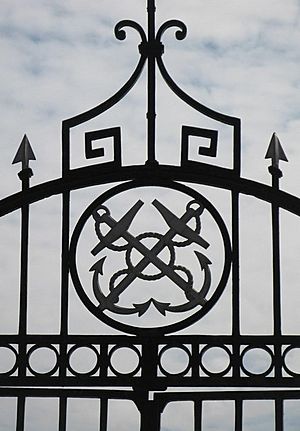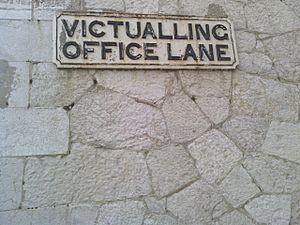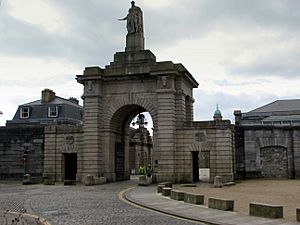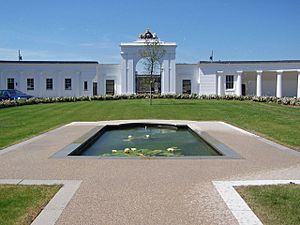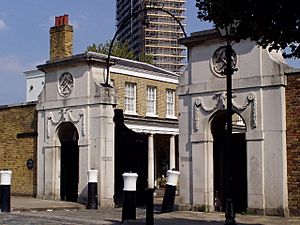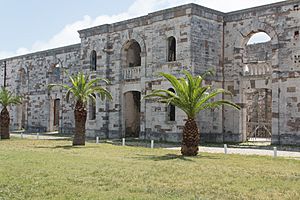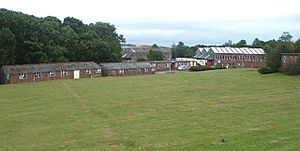Victualling Commissioners facts for kids

Emblem of the Victualling Board, as seen across its Yards and Depots.
|
|
| Agency overview | |
|---|---|
| Formed | (1683-1832) |
| Preceding agency |
|
| Superseding agency | |
| Jurisdiction | |
| Headquarters | London |
| Agency executive |
|
| Parent agency | Admiralty |
The Victualling Board was a very important group of people who made sure the British Royal Navy had enough food and drinks. Imagine feeding 140,000 sailors in 1810! This board had to provide food and supplies to keep them healthy and ready for battle. They did this even when ships were far away for months.
The official name was the Commissioners for the Victualling of the Navy. They worked from 1683 until 1832. After that, other departments took over their job.
Contents
How it Started
Back in 1550, during the time of Elizabeth I, there was an officer called the General Surveyor of Victuals. His job was to check contracts for food and supplies for the Navy. He was one of seven main officers of the Navy Board. His goal was to always have enough food for a thousand sailors at sea for one month.
At first, the Victualling Office was inside the Tower of London. But it quickly grew outside. It had big storehouses, ovens, and bakeries. They even got a slaughterhouse in Deptford in 1650. Officials worked here for a long time. However, it was hard to get supplies to this location. So, in 1672, a new main food-making place was built in Deptford. This became the Deptford Victualling Yard.
By the mid-1600s, one company usually provided all the food. The Navy Board set strict rules for food quality. In the 1660s, Samuel Pepys changed how supplies were given out. Each ship's Purser (the person in charge of supplies) had to pay a deposit. They also had to keep careful records of everything.
However, during the Anglo-Dutch Wars, this system started to fail. The government said they didn't get enough food. The contractors said they weren't paid. Because of these problems, a new group of paid officials was created in 1683. This was the Victualling Board, and they managed food supplies for the next 150 years.
Even though the Victualling Board was officially under the Navy Board, it mostly worked on its own. In 1817, it also took over medical services. The Victualling Board was closed down in 1832. Its duties were then handled by other departments within the Admiralty.
What They Did
By 1739, keeping the Victualling Office running cost a lot of money. This was on top of buying the food itself. Over time, all the food-making and storage places were put together. These were called Victualling Yards. Each Yard had many different processes and storehouses in one place.
These Yards had special docks for ships. They were easy to reach from where the Navy ships usually waited. Ships that were about to sail would come to the nearest Yard to load up. They would get preserved foods that could last for weeks or months. This included ship's biscuit, salted beef, salted pork, peas, oatmeal, butter, cheese, and beer. Most of these items were kept in large wooden barrels. The Board even made these barrels themselves in special workshops called cooperages. The Victualling Yards also provided fresh meat and bread for ships in port.
The Board always tried to stop corruption and make food quality better. For example, in 1658, sailors on HMS Maidstone destroyed the Victualling Office in Rochester. They were angry about the terrible food quality. The Board made most of the food itself to ensure good quality. It was easier to check raw materials than finished products bought from other companies. So, the Commissioners managed not only buying but also making food. They made beer from hops, flour from grain, and meat from livestock.
The system improved over time. Even if the food wasn't perfect, there was always a lot of it. Studies show that in the mid-1700s, sailors got almost twice as many calories as people on land. Beer was the biggest source of calories. Each sailor got about one gallon of beer per day! The Board provided food like bread, pork, beef, peas, and oatmeal. These supplies could last up to six months. By the late 1750s, they also added portable soup. By the time of the Napoleonic Wars, only about 1% of supplies were considered too bad to eat.
The Victualling Yards
Early Yards (Before 1815)
By the early 1700s, Victualling Yards were built next to several Royal Naval Dockyards in Britain. These included Portsmouth, Plymouth, Deptford, and Harwich. There was also a Yard in Dover, which served ships in a nearby anchorage called the Downs.
HM Victualling Yard, Deptford was the biggest and busiest Yard. It was close to London's food markets. Other Naval Dockyards in the Thames area, like Chatham and Sheerness, got their food from Deptford. Deptford also supplied a Victualling Yard at Gibraltar.
In the early 1800s, new smaller Yards were built at Sheerness and Deal. Later, a large complex of naval and victualling storehouses was built on Haulbowline Island in Ireland. It was called the Royal Alexandra Victualling Yard.
For overseas ships, food was often bought from local suppliers. Sometimes, a special Agent appointed by the Victualling Commissioners managed this. In the 1600s, there were Agents in places like Leghorn and Tangiers. By 1810, they were in places like Malta, Rio de Janeiro, and the Cape. Most buildings overseas were rented, not specially built. However, a Victualling Yard was built in Gibraltar in 1799 and stayed open until the 1980s.
Newer Yards (1815-1900)
The Victualling Yards in Britain had grown without much planning. So, in 1822, the Victualling Board decided to build a new, organized Yard in Plymouth. It was called the Royal William Victualling Yard. It had a large main storehouse. On either side were big buildings for making food: a mill/bakery and a brewery. Other buildings included cooperages for making barrels, houses for officers, and a slaughterhouse. All the buildings were made of matching limestone and arranged in a neat pattern.
A similar plan was used for Portsmouth. The new Royal Clarence Victualling Yard started in 1827 in Gosport. Here, the layout was less strict because an old cooperage was included. But it still looked impressive from the water. Royal Clarence was one of the first big industrial food factories in the country. Many important buildings from that time are still there today.
Both the 'William' and 'Clarence' yards were named after the future King William IV. He was very interested in these projects. These Yards were designed to store, make, and deliver food to ships very efficiently. They also looked grand and symmetrical from the sea. The Royal William Yard is special. It's described as "a unique concept in English industrial history."
Deptford's Yard was not rebuilt in the same way, but it kept growing. It became very large, covering 35 acres. In the 1800s, Deptford started to store and make more special foods. It had mills for cocoa, pepper, and mustard. There were also storehouses for tea, sugar, rice, raisins, and wine. In 1858, Deptford was renamed the Royal Victoria Victualling Yard.
Overseas, new Yards and storehouses were built when needed. For example, on Ascension Island, a victualling storehouse was built by 1827. It later got a bakery and water tanks. In 1845, a Victualling Yard was built at Malta Dockyard. The Malta Maritime Museum is now in one of its old buildings. Around the same time, work began on the dockyard complex in Bermuda. This Yard had two long storehouses facing each other, a cooperage, and officers' houses. It was finished around 1860.
Modern Times (1900-Present)
New Victualling Yards were still being built in the early 1900s. These included the Royal Elizabeth Yard in Scotland and the Royal Edward Yard in Australia. How food was provided didn't change much until tinned foods and refrigeration became common. At Gosport, the cooperage (barrel-making workshop) worked until 1970. This was when the Navy stopped giving sailors a daily rum ration.
Deptford's Royal Victoria Yard closed in 1961. Now, houses are built there, but some old buildings are still used by the community. The Yards on the South Coast, Royal Clarence and Royal William, both closed in 1992. Their buildings have been sold and turned into homes, offices, and places for fun.
How the Board Was Organized
Each Commissioner on the Board was in charge of a different part of the food supply. There were departments for the Brewhouse (making beer), the Cutting House (preparing meat), Dry Goods, Cooperage (making barrels), and Stores. There were seven Commissioners in total. Six managed these departments, and the Chairman oversaw the money.
The Victualling Board built its own breweries, slaughterhouses, mills, and bakeries. These were near the Royal Navy Dockyards. This allowed them to make beer, salted meat, ship's biscuits, and other supplies. They could control the quality themselves. In 1725, the Victualling Commissioners and other Navy offices moved into new buildings at Somerset House.
Timeline of Responsibility
- Navy Board, Surveyor of Marine Victuals: 1550-1679
- Navy Board, Victualling Board (Board of Victualling Commissioners): 1683-1832
- Board of Admiralty, Comptroller of Victualling and Transport Services: 1832-1862
- Board of Admiralty, Comptroller of Victualling: 1862-1870
- Board of Admiralty, Contract and Purchase Department: 1869-1964
- Board of Admiralty, Superintendent of Victualling: 1870-1878
- Board of Admiralty, Director of Victualling: 1878-1964


